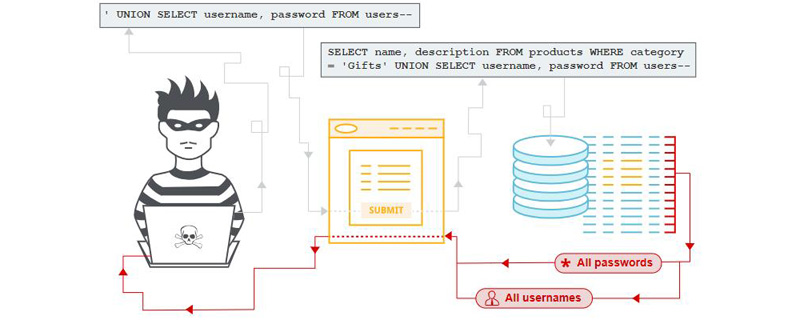Home >Database >Mysql Tutorial >How to prevent SQL injection attacks?
How to prevent SQL injection attacks?
- 青灯夜游Original
- 2019-03-22 10:14:3718737browse
SQL injection is an injection attack that can execute malicious SQL statements. The following article will introduce you to SQL injection and briefly introduce methods to prevent SQL injection attacks. I hope it will be helpful to you.

What is SQL injection?
SQL injection (SQLi) is an injection attack that can execute malicious SQL statements. It gives attackers complete control over the database server behind a web application by inserting arbitrary SQL code into database queries. Attackers can use SQL injection vulnerabilities to bypass application security measures; they can bypass authentication and authorization of a web page or web application and retrieve the contents of an entire SQL database; they can also use SQL injection to add, modify, and delete items in the database. Record.
SQL injection vulnerabilities can affect any website or web application that uses a SQL database such as MySQL, Oracle, SQL Server, or others. Criminals may use it to gain unauthorized access to users' sensitive data: customer information, personal data, trade secrets, intellectual property, etc. SQL injection attacks are one of the oldest, most popular, and most dangerous web application vulnerabilities.
Types of SQL Injection Attacks
SQL injection attacks can be performed in a variety of ways. An attacker may observe the behavior of a system before choosing a specific attack method.
In-band injection
This is a typical attack where the attacker can launch the attack through the same communication channel and obtain the results. This is done through two in-band techniques:
● Error-based SQL injection: obtains information about the database from the displayed error message
● Union-based SQL injection: relies on The attacker was able to connect the results of UNION ALL's stolen information with legitimate results.
Both techniques rely on the attacker modifying the SQL sent by the application, as well as the errors displayed in the browser and the information returned. It will succeed if the application developer or database developer fails to properly parameterize the values they use in the query. Both are trial and error methods and errors can be detected.
Blind Injection
Also known as inferential SQL injection, a blind injection attack does not display data directly from the target database; instead, the attacker carefully examines the behavior Indirect clues. Details in the HTTP response, blank web pages for certain user inputs, and how long it takes for the database to respond to certain user inputs can all be clues, depending on the attacker's goals. They can also point to another SQLi attack vector attempted by the attacker.
Out-of-Band Injection
This attack is somewhat sophisticated and may be used by an attacker when he is unable to achieve his goal in a single direct query-response attack attack. Typically, attackers craft SQL statements that, when presented to the database, trigger the database system to create a connection to an external server controlled by the attacker. In this way, an attacker can collect data or possibly control the behavior of the database.
Second-order injection is an out-of-band injection attack. In this case, the attacker will provide a SQL injection that will be stored and executed by a separate act of the database system. When secondary system behavior occurs (it could be something like a time-based job or something triggered by other typical administrators or users using the database) and the attacker's SQL injection is performed, that's when "reaching out" to the system Attacker control occurs.
How to prevent SQL injection attacks?
The following suggestions can help prevent successful SQL injection attacks:
1. Do not use dynamic SQL
Avoid providing the user with The input is put directly into the SQL statement; it is better to use prepared statements and parameterized queries, which is safer.
2. Do not keep sensitive data in plain text
Encrypt private/confidential data stored in the database; this provides another level of protection to Prevent attackers from successfully expelling sensitive data.
3. Limit database permissions and privileges
Set the capabilities of the database user to the minimum required; this will limit what an attacker can do if they manage to gain access. .
4. Avoid displaying database errors directly to the user
An attacker can use these error messages to obtain information about the database.
5. Use a Web Application Firewall (WAF) for web applications that access the database
This provides protection for web-oriented applications and it can help identify SQL injection attempts; depending on the settings, it can also help prevent SQL injection attempts from reaching the application (and therefore the database).
6. Regularly test web applications that interact with databases
Doing so can help catch new bugs or regressions that could allow SQL injection.
7. Update the database to the latest available patches
This prevents attackers from exploiting known weaknesses/bugs present in older versions.
Summary: SQL injection is a popular attack method, but by taking appropriate precautions, such as ensuring data is encrypted, your web application is secured and tested, and that you are up to date with patches, You can take meaningful steps to keep your data secure.
Recommended video tutorials: "MySQL Tutorial"
The above is the entire content of this article, I hope it will be helpful to everyone's learning. For more exciting content, you can pay attention to the relevant tutorial columns of the PHP Chinese website! ! !
The above is the detailed content of How to prevent SQL injection attacks?. For more information, please follow other related articles on the PHP Chinese website!

